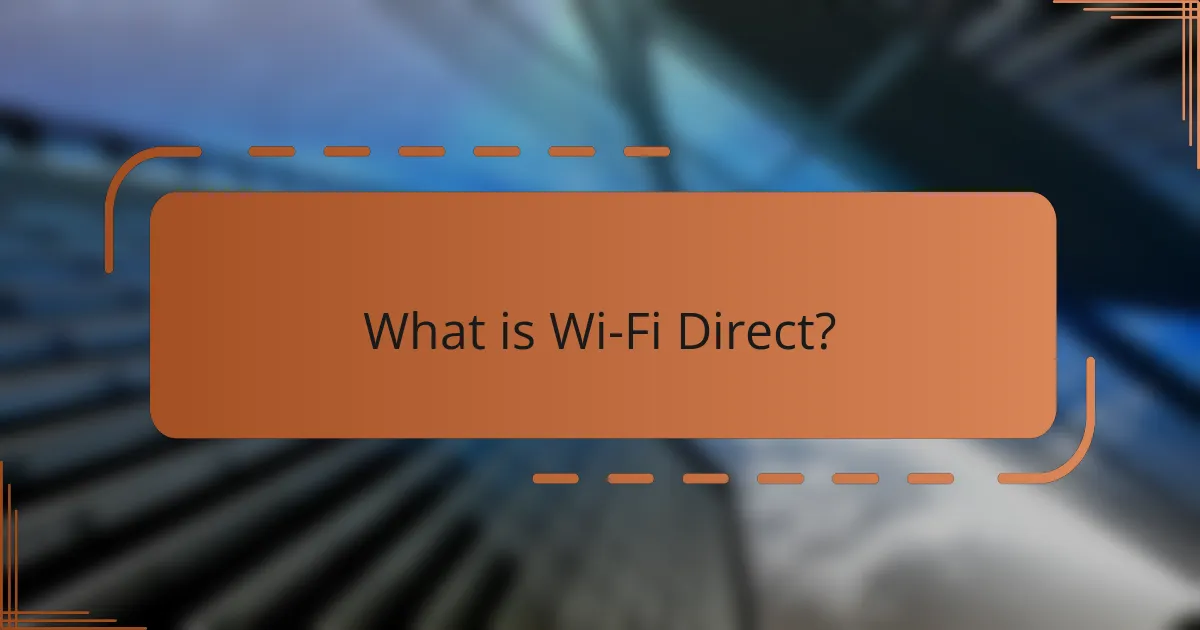Wi-Fi Direct is a peer-to-peer technology that enables devices to connect directly without the need for a wireless access point, allowing for efficient file sharing, printing, and streaming. Operating on standard Wi-Fi protocols, it ensures high-speed connections and automatic device discovery. While Wi-Fi Direct incorporates security measures like WPA2 encryption, users must implement proper security practices to mitigate risks such as unauthorized access and man-in-the-middle attacks. The technology supports various applications, including seamless presentations, multiplayer gaming, and mobile printing, enhancing productivity and connectivity in mobile business environments.

What is Wi-Fi Direct?
Wi-Fi Direct is a technology that allows devices to connect directly to each other without needing a wireless access point. It enables peer-to-peer connections for file sharing, printing, and streaming. Wi-Fi Direct operates on the same Wi-Fi standards, ensuring high-speed connections. Devices can discover and connect to each other automatically. This technology supports a wide range of devices, including smartphones, printers, and TVs. Wi-Fi Direct is secure, employing WPA2 encryption for data protection. It simplifies connectivity by eliminating the need for complex network configurations.
How does Wi-Fi Direct differ from traditional Wi-Fi?
Wi-Fi Direct allows devices to connect directly without requiring a traditional access point. In contrast, traditional Wi-Fi typically requires a router to facilitate communication between devices. Wi-Fi Direct establishes a peer-to-peer connection, enabling faster data transfer rates. This connection can be established quickly, often in seconds, without complex setup. Traditional Wi-Fi may involve more steps for device connection. Wi-Fi Direct supports a wider range of devices, including printers and cameras, enhancing functionality. Traditional Wi-Fi primarily focuses on connecting devices to the internet. Wi-Fi Direct connections can be more secure through direct encryption. In summary, Wi-Fi Direct simplifies connectivity and enhances direct device communication compared to traditional Wi-Fi.
What are the key features of Wi-Fi Direct?
Wi-Fi Direct enables devices to connect directly without a wireless access point. This technology supports peer-to-peer connections. Wi-Fi Direct operates at speeds comparable to traditional Wi-Fi networks. It allows for easy file sharing and printing between devices. Security protocols like WPA2 protect the connections. Wi-Fi Direct is compatible with a wide range of devices, including smartphones and printers. The technology simplifies setup with its automatic device discovery feature. This enhances user experience by reducing complexity in connecting devices.
How is a connection established in Wi-Fi Direct?
A connection in Wi-Fi Direct is established through a process known as device discovery and pairing. First, one device acts as a Group Owner (GO) while the other device connects as a client. The GO broadcasts its presence to nearby devices using Wi-Fi Direct’s service discovery feature. Once a client device detects the GO, it sends a connection request. The GO then accepts the request, initiating a negotiation phase. During this phase, the devices agree on connection parameters, such as security settings. After successful negotiation, a secure connection is established, allowing for direct data transfer. This process ensures that devices can communicate without the need for a traditional Wi-Fi network.
What are the advantages of using Wi-Fi Direct?
Wi-Fi Direct offers several advantages for device connectivity. It allows devices to connect directly without requiring a traditional Wi-Fi network. This direct connection can improve transfer speeds, often reaching up to 250 Mbps. Wi-Fi Direct also enhances security through WPA2 encryption, protecting data during transfers. It supports multiple devices simultaneously, facilitating group sharing and collaboration. Additionally, Wi-Fi Direct is compatible with a wide range of devices, including smartphones, printers, and TVs. This versatility makes it an ideal solution for mobile business applications.
How does Wi-Fi Direct enhance mobile business connectivity?
Wi-Fi Direct enhances mobile business connectivity by enabling direct peer-to-peer connections between devices without the need for a traditional network. This technology allows devices to communicate and share data quickly and efficiently. It supports high-speed data transfers, often reaching speeds of up to 250 Mbps. Wi-Fi Direct also simplifies the connection process, allowing users to connect devices with a few taps. Security features, such as WPA2 encryption, ensure that data remains protected during transfers. According to the Wi-Fi Alliance, Wi-Fi Direct can facilitate seamless collaboration in business environments. This capability is crucial for tasks like file sharing and printing on the go. Overall, Wi-Fi Direct significantly improves connectivity by providing a fast, secure, and convenient solution for mobile business operations.
What speed benefits does Wi-Fi Direct offer?
Wi-Fi Direct offers high-speed data transfer rates, typically reaching up to 250 Mbps. This speed is significantly faster than traditional Wi-Fi connections, which often experience latency. Wi-Fi Direct establishes a direct connection between devices, reducing the need for an intermediary access point. This direct connection minimizes transmission delays and enhances overall performance. Additionally, Wi-Fi Direct supports multiple simultaneous connections, allowing multiple devices to communicate efficiently. The technology utilizes Wi-Fi Alliance’s Wi-Fi Direct specification, which ensures compatibility and optimized performance across devices. These speed benefits make Wi-Fi Direct suitable for applications requiring quick data transfer, such as file sharing and media streaming.

How secure is Wi-Fi Direct?
Wi-Fi Direct has moderate security features. It uses WPA2 encryption for secure connections. This ensures that data transferred between devices is encrypted. However, the security largely depends on user implementation. If users do not secure their devices properly, vulnerabilities may arise. Wi-Fi Direct supports device authentication to prevent unauthorized access. Despite these measures, risks such as man-in-the-middle attacks exist. Users should remain cautious and monitor their connections. Regular updates to device firmware can enhance security.
What security protocols are implemented in Wi-Fi Direct?
Wi-Fi Direct implements several security protocols to ensure secure connections. The primary protocol is Wi-Fi Protected Access (WPA2), which provides strong encryption and authentication. WPA2 uses Advanced Encryption Standard (AES) for data protection. Additionally, Wi-Fi Direct supports a Personal Identification Number (PIN) method for secure pairing. This method enhances security by requiring a PIN entry during the connection process. Furthermore, it also allows for the use of a push-button method for easy and secure connections. These protocols collectively ensure that data transmitted over Wi-Fi Direct is protected against unauthorized access and eavesdropping.
How does Wi-Fi Direct ensure data privacy?
Wi-Fi Direct ensures data privacy through secure connections and encryption protocols. It establishes a peer-to-peer connection that does not require a traditional access point. This direct connection minimizes exposure to external networks. Wi-Fi Direct employs WPA2 encryption to safeguard data during transmission. WPA2 is a well-established security standard that provides strong encryption. The use of this protocol protects sensitive information from unauthorized access. Additionally, devices must authenticate each other before establishing a connection. This mutual authentication further enhances security and privacy. Overall, Wi-Fi Direct’s design prioritizes secure data exchange between devices.
What are the potential security risks associated with Wi-Fi Direct?
Wi-Fi Direct poses several potential security risks. One major risk is unauthorized access to devices. Devices can connect without prior authentication, leading to potential data breaches. Another risk is data interception. Since Wi-Fi Direct may not encrypt all data transfers, sensitive information can be exposed. Additionally, users may unknowingly connect to rogue devices, which can lead to man-in-the-middle attacks. These risks highlight the importance of implementing strong security measures. Regular software updates and user awareness can help mitigate these vulnerabilities.
How can businesses enhance security when using Wi-Fi Direct?
Businesses can enhance security when using Wi-Fi Direct by implementing strong authentication methods. Utilizing WPA3 encryption ensures that data transferred over the connection is secure. Regularly updating device firmware helps protect against known vulnerabilities. Limiting Wi-Fi Direct connections to trusted devices reduces the risk of unauthorized access. Employing network segmentation can isolate Wi-Fi Direct traffic from critical business systems. Monitoring and logging Wi-Fi Direct connections aids in identifying suspicious activities. Training employees on secure usage practices further strengthens security measures. These strategies collectively create a robust security framework for Wi-Fi Direct usage in business environments.
What best practices should be followed for secure connections?
Use strong encryption protocols like WPA3 for secure connections. WPA3 offers enhanced security compared to its predecessor, WPA2. Regularly update firmware on devices to protect against vulnerabilities. Keeping software up-to-date reduces the risk of security breaches. Use strong, unique passwords for network access. Weak passwords can be easily guessed or cracked. Disable guest access on networks when not needed. This prevents unauthorized users from connecting. Regularly monitor connected devices to identify any unauthorized access. Identifying intrusions early can help mitigate potential threats. Implement network segmentation to isolate sensitive data. This limits exposure in case of a breach.

What are the applications of Wi-Fi Direct in mobile business?
Wi-Fi Direct enables direct connections between devices without a router. It facilitates file sharing, enabling quick transfer of documents and multimedia between mobile devices. This direct connection enhances collaboration during meetings by allowing participants to share presentations seamlessly. Wi-Fi Direct supports printing from mobile devices to compatible printers, streamlining operations in business environments. It also allows for multiplayer gaming and interactive applications, enhancing team building and engagement. Additionally, Wi-Fi Direct can be used for connecting mobile devices to displays for presentations, improving visual communication. These applications demonstrate Wi-Fi Direct’s versatility in enhancing productivity and connectivity in mobile business settings.
How is Wi-Fi Direct used in file sharing and collaboration?
Wi-Fi Direct enables peer-to-peer connections for file sharing and collaboration. It allows devices to connect directly without a traditional network. This feature facilitates quick transfer of files such as documents, photos, and videos. Users can initiate file sharing easily through compatible applications. Wi-Fi Direct supports high-speed data transfer rates, often exceeding 20 Mbps. This speed enhances the efficiency of collaborative tasks. Devices can maintain a secure connection using WPA2 security protocols. As a result, sensitive information remains protected during transfers. Wi-Fi Direct is widely supported across various platforms, including Android and Windows. This broad compatibility increases its utility in diverse environments.
What tools and applications leverage Wi-Fi Direct for business purposes?
Wi-Fi Direct is leveraged by various tools and applications for business purposes. Notable applications include file-sharing apps like ShareIt and Zapya, which enable quick transfer of files between devices without a traditional network. Printing applications such as HP ePrint utilize Wi-Fi Direct for direct printing from mobile devices. Collaboration tools like Cisco WebEx also leverage Wi-Fi Direct for seamless connectivity during meetings. Additionally, point-of-sale systems in retail environments use Wi-Fi Direct for secure transactions. These tools enhance productivity and streamline operations by facilitating direct device connections.
How does Wi-Fi Direct support remote work and mobile teams?
Wi-Fi Direct enables seamless connections between devices without the need for a traditional network. This capability supports remote work by allowing teams to share files and resources directly. Mobile teams can connect smartphones, tablets, and laptops easily. The technology facilitates collaboration in real-time, enhancing productivity. Wi-Fi Direct operates at high speeds, which is essential for transferring large files quickly. It also maintains a secure connection, protecting sensitive data during transfers. This makes it ideal for business environments where security is a priority. Overall, Wi-Fi Direct streamlines communication and resource sharing for remote and mobile teams.
What industries are benefiting from Wi-Fi Direct technology?
The industries benefiting from Wi-Fi Direct technology include healthcare, retail, and entertainment. In healthcare, Wi-Fi Direct enables secure data transfer between medical devices and systems. This enhances patient monitoring and data accuracy. Retailers use Wi-Fi Direct for mobile payments and inventory management. It improves customer experience and operational efficiency. The entertainment industry leverages Wi-Fi Direct for seamless content sharing between devices. This facilitates quick streaming and sharing of media. Overall, these industries utilize Wi-Fi Direct for improved connectivity and efficiency in various applications.
How does Wi-Fi Direct improve operations in retail environments?
Wi-Fi Direct enhances operations in retail environments by enabling direct device connections without a traditional network. This allows for faster data transfer between devices, improving communication efficiency. Retail staff can share information instantly, such as inventory updates or promotional materials. The technology supports multiple connections simultaneously, facilitating teamwork among employees. Wi-Fi Direct also enhances customer experiences through features like mobile payments and interactive displays. Security is improved as devices connect directly, reducing exposure to potential network vulnerabilities. Overall, Wi-Fi Direct streamlines processes, boosts productivity, and enhances customer engagement in retail settings.
What role does Wi-Fi Direct play in healthcare applications?
Wi-Fi Direct enables seamless peer-to-peer connections between devices in healthcare applications. It allows medical devices to communicate without the need for a traditional network. This capability enhances data transfer speed and reliability. For instance, patient monitoring devices can share data directly with smartphones or tablets. Wi-Fi Direct also improves security by encrypting connections. This is crucial for protecting sensitive patient information. Additionally, it reduces the reliance on centralized networks, ensuring continuous device operation. Overall, Wi-Fi Direct facilitates efficient and secure data exchange in healthcare settings.
What are the best practices for implementing Wi-Fi Direct in a business setting?
To implement Wi-Fi Direct effectively in a business setting, ensure proper device compatibility. Check that all devices support Wi-Fi Direct standards. Establish a secure connection by using WPA2 encryption to protect data. Limit device discovery to authorized personnel to prevent unauthorized access. Regularly update device firmware to address security vulnerabilities. Train employees on Wi-Fi Direct usage and security protocols to enhance awareness. Monitor network performance to optimize connectivity and troubleshoot issues promptly. These practices improve security, efficiency, and user experience in a business environment.
Wi-Fi Direct is a technology that enables direct peer-to-peer connections between devices without the need for a traditional wireless access point, facilitating file sharing, printing, and streaming. The article covers key features of Wi-Fi Direct, including its high-speed data transfer rates, security protocols like WPA2 encryption, and the process of establishing connections. It also explores the advantages of Wi-Fi Direct for mobile business connectivity, its applications in various industries such as healthcare and retail, and best practices for secure implementation in business settings. Overall, the article provides a comprehensive overview of how Wi-Fi Direct enhances connectivity and efficiency in mobile business operations.


